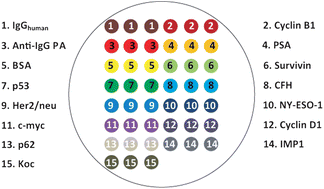Multiplexed immunoassay for the rapid detection of anti-tumor-associated antigens antibodies
Abstract
TAAs (tumor-associated

* Corresponding authors
a
Equipe Génie Enzymatique, Membranes Biomimétiques et Assemblages Supramoléculaires, Institut de Chimie et Biochimie Moléculaires et Supramoléculaires, Université Lyon 1—CNRS 5246 ICBMS, Bâtiment CPE—43, bd du 11 novembre 1918, Villeurbanne, Cedex, France
E-mail:
christophe.marquette@univ-lyon1.fr, christophe.marquette@axoscience.com
b Etablissement Français du Sang Rhône-Alpes, Lyon, France
TAAs (tumor-associated

 Please wait while we load your content...
Something went wrong. Try again?
Please wait while we load your content...
Something went wrong. Try again?
C. Desmet, G. C. Le Goff, J.-C. Brès, D. Rigal, L. J. Blum and C. A. Marquette, Analyst, 2011, 136, 2918 DOI: 10.1039/C1AN15121E
To request permission to reproduce material from this article, please go to the Copyright Clearance Center request page.
If you are an author contributing to an RSC publication, you do not need to request permission provided correct acknowledgement is given.
If you are the author of this article, you do not need to request permission to reproduce figures and diagrams provided correct acknowledgement is given. If you want to reproduce the whole article in a third-party publication (excluding your thesis/dissertation for which permission is not required) please go to the Copyright Clearance Center request page.
Read more about how to correctly acknowledge RSC content.
 Fetching data from CrossRef.
Fetching data from CrossRef.
This may take some time to load.
Loading related content
